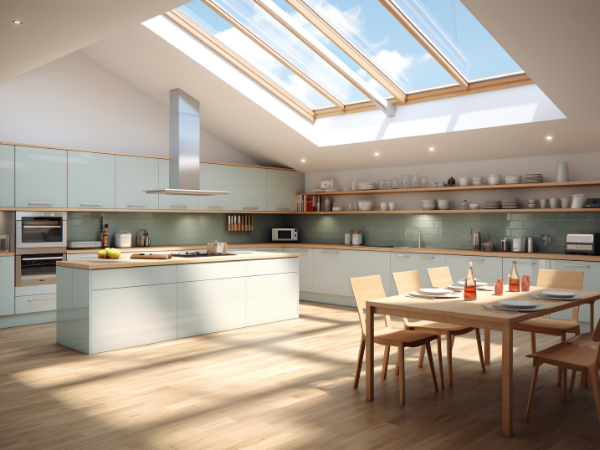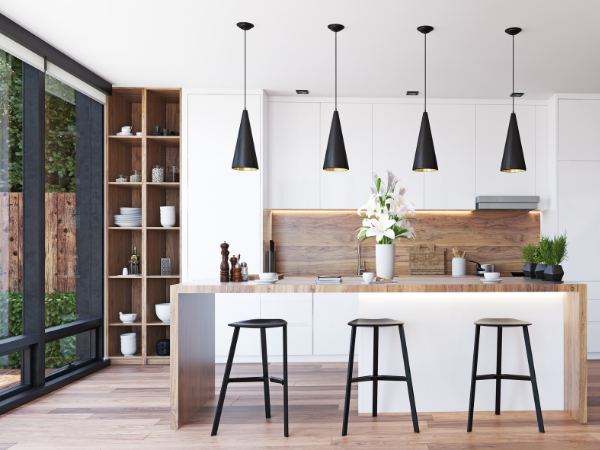
How to invite more natural light into your kitchen
There’s nothing quite like starting your day in a kitchen bathed in the gentle glow of morning sunlight or preparing dinner as the evening’s golden rays stream in.
But there’s more to it than aesthetics. A study by Maastricht University School of Business and Economics discovered that ambient brightness influences the overall taste intensity perception of your food. Think about that for a moment. The lighting of your kitchen can, quite literally, make or break your culinary experiences. The good news is that, with some thoughtful adjustments and changes, you can bring more of it into your home.
Rethink your kitchen design: If feasible, consider an open floor plan by removing non-load-bearing walls or creating cutouts between your kitchen and adjacent rooms. This can let light pour in unobstructed for a brighter environment.
Embrace a lighter palette: Using light colours can help reflect light around the room. Because of this, your kitchen will look bigger and brighter while also having a modern flair. Pure white is typically the best but if you find it too stark, you can opt for beiges, light greys, and pastels. Consider light-coloured countertops, walls, and cabinets.
Light up with windows: If your home's architecture allows it, explore expanding the size of your current windows or adding an additional window to the kitchen. No space? You can get creative with narrow windows tucked between cabinets and shelves to maximise the light you receive.
Pick the right window treatments: Your kitchen window should be free of any heavy or dark curtains. Use sheer curtains or lightweight blinds that allow sunlight to filter through while maintaining privacy. To enhance the effect, you should also trim or remove any overgrown plants and trees that might be obstructing your view.

Install a skylight: These bring natural light from above, drenching your space in natural light. On a cloudless night, you can even get moonlight and enjoy some stargazing as you prepare meals. Skylights are best positioned over high-traffic areas like your kitchen island, table, or countertops.
Seek out solar tubes: If your roof structure doesn’t allow direct access to the kitchen, solar tubes are a less invasive but still effective alternative to skylights. These cylindrical tubes of reflective material channel daylight into your kitchen from the rooftop. Although they bring in less light than a skylight or window, you can add a number of them to capitalise on the sun’s glorious rays.
Clear the way with glass doors: If your kitchen has a door leading to the outside, consider replacing it with a full or partial glass door. This truly helps to expand the flow of light throughout your kitchen, especially in those dark corners.
Boost brightness with glass blocks: If your budget and space permit it, replace sections of your exterior wall with glass panels or blocks. They still keep your kitchen private but allow light to enter your home. This can be a tricky project so it’s best to have a professional make the change.
See the shine with glass cabinets: Installing glass-fronted cabinets lets light filter through to their interiors. Besides making it easier to find items, they’re a great way to display some of your prettier kitchenware. If you’re not a fan of the look, you can also consider open shelves.
Buy reflective kitchen items: Shiny decor and appliances bounce light around your kitchen. Whether it’s a glossy exterior or metallic sheen, these can reflect natural light from a window. Just take care that any additions to your kitchen don’t block lighting from a window or other sources of light.
Choose surfaces that gleam: Glass or ceramic tiles reflect light from the ground up. For your countertops, invest in marble, quartz, or metallic options like stainless steel or copper. Depending on your surface, you can even use a light-reflective paint finish to give existing countertops a makeover. Whichever route you choose, ensure you keep these surfaces clean and polished so they can give you the full benefit of their light-boosting qualities.
Get glowing with mirrors: Placing mirrors on walls or backsplashes opposite windows can help to reflect and amplify natural light. Plus, they have the power to make a small kitchen space feel larger. There are plenty of shapes and framing options that will work with your kitchen’s aesthetic.

Natural kitchen lighting FAQs
1. What are the benefits of natural light in the kitchen?
Natural light in the kitchen has so many positive benefits. It enhances your mood and boosts energy by aiding in Vitamin D production. Having natural light in the kitchen improves the accuracy and safety of food preparation and promotes a healthier environment by reducing mould and bacteria growth. Natural light also cuts back on the need for electricity during the day, which can help reduce energy costs.
2. How do you get natural light in your kitchen?
There are plenty of ways. The focus should be on embracing lighter colours, changing your kitchen design in ways that boost light, and using reflective surfaces and accessories.
3. Why are shadows important while designing interior lighting?
Shadows play an important role in interior lighting, especially for your kitchen. They add visual appeal, create depth, highlight surfaces and textures, and make a space feel more dynamic. Proper shadowing also ensures task areas are well-lit, improving functionality and safety.

Revel in your kitchen’s radiance
Your well-lit kitchen will make cooking and eating all the better. But it will also earn you plenty of admirers, including potential buyers and renters if you’re on the market. Let Seeff showcase your kitchen at its best and help you find success on the property market. Reach out to our team today for professional service.







